Maybe I'm wrong in that because there is one big open secret in Scottish politics that is now "confided" to me, it seems. by virtually every second person I meet. Maybe somebody will run it before the Summer but I suspect it will, in the end, be saved for when it might really be needed.
So, I thought I might take the opportunity of the Jubilee weekend just to indulge in a further bit of whimsy and to share my ten favourite paintings.
Dedicated readers of this blog will know the eventual winner. Such is the peril of the writer not planning ahead. Here, nonetheless, after a brief setting of terms, are the other nine. And the winner again.
The terms are that no painter, with one exception, can appear twice and that all of the paintings must be ones I've seen in real life. Thus, no Mona Lisa, since, despite various false starts, my one and only visit to Paris was at an age when the Musee des Invalides held a much greater attraction than the Louvre.
It is also, I admit, a pretty commonplace list but, then again, the reason great paintings are regarded as great paintings is because they are great paintings. Generally regarded as better than merely very good paintings. A list of the world's ten greatest footballers that did not include Pele or Maradona would be regarded as an eccentric choice. I proceed in that spirit.
And I also acknowledge the omissions. Not one painting in Florence. No Fra Angelico, possibly the most spiritual of all painters. And from being senza Firenze thus, more or less, neither Lippi; no Masaccio either.
No Sienese art either or even Leonardo (no Leonardo!); no Giotto, though here more by being spoiled for choice.
Not even excepting the Caravaggio, no real Counter-Reformation art, this time through taste rather lack of space.
And no painting by a British, let alone Scottish artist. If I was choosing my favourite ten books it would be different but horses for courses. If I was choosing my ten favourite pieces of music I'd be equally unpatriotic.
So here we go
1. The taking of Christ (Caravaggio). National Gallery of Ireland, Dublin

The Caravaggio. I love Caravaggio, More even than the choice between the paintings of my main man, choosing even a Caravaggio was difficult. Both of my favourite churches in Rome (San Luigi dei Francesi and Santa Maria del Popolo) occupy their position substantially because of paintings by this man, although the former also benefits from being close to my favourite restaurant in Rome.
But this is as good as anything he did. As always, the unusual lighting angle, here magnified further by the light striking off the armour but the real attraction to me comes from two sources. The first is in the back story, which, much as I would like to claim it as my own must properly be derived from a link . The second is the way in which it was displayed in Dublin the first time I saw it; at the very end of a corridor you saw almost immediately upon entry but which could only be reached by proceeding along that corridor while being lured away by the numerous side galleries on the way.
The last time I was there it had been given a room of its own and as I left I remarked on this to one of the curators. "Everybody makes that complaint", he replied, implying by his body language that it was not a relocation he approved of. Here's hoping everybody has been listened to by the time I return
2. Christ of St John of the Cross (Dali) Kelvingrove Art Gallery and Museum, Glasgow
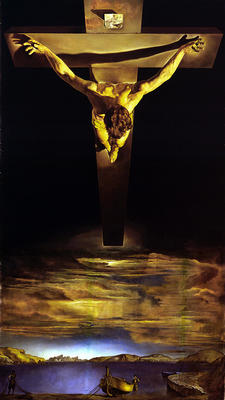
First of all, I should apologise for my earlier disavowal of Counter-Reformation paintings. For this, although almost painted in my lifetime, could very nearly be by Murillo or Zubaran and enthusiastically endorsed by the Jesuits. The political background to this being painted at all kind of defeats me. It's here however because, of all the paintings listed, it is the one I have easily seen the most often. For it is in Glasgow and in the midst of even a gallery containing some fine other works it is nonetheless never encountered with anything less than a gasp.
I hesitate to say that it is the painting worst served here by reproduction in A4 as the sense of vertigo captured by the original can't even remotely be appreciated in this format. And unlike my other selections, you don't need to travel to appreciate that. Just get the Underground to Kelvingrove.
3. Santa Maria dei Fossi altarpiece (Pinturricio) Galleria Nazionale dell' Umbria, Perugia.
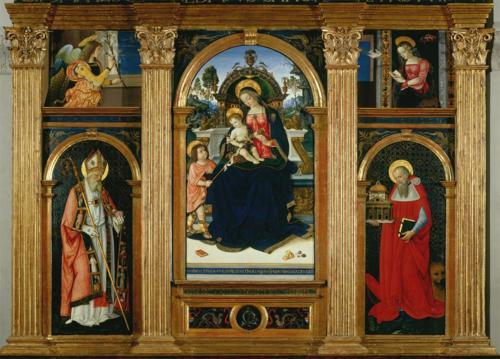
You can't entirely separate a painting from where you see it. I had to have a Pinturricio but I chose this ahead of anything from Siena or Spello chiefly because it is in my favourite Gallery in the world, the Galleria Nazionale dell Umbria in Perugia. The Gallery is situated in the building of ancient Comune, directly off the main Corso Vanucci. The very best time to go is during the Jazz Festival when they erect a gigantic Sound Stage in the Square outside the Cathedral, just at the exit to the Gallery. One Sunday morning past we emerged at lunchtime to discover a massed black gospel choir singing, as an encore, When the Saints go Marching In. I phoned my eight year old nephew and held the phone up for him to hear. "Why," he eventually inquired "are they singing that? Are they from Paisley?"
The altarpiece itself is everything you would expect from the artist with the vivid reds in the cloaks of the supporting Saints to the overall grandeur of the conception. And a great Madonna. Ah.............time for lunch at Il Mangar Bene, just round the corner.
4. The School of Athens (Rafaello) Vatican Museum, Rome

Genius. Almost enough said. The apotheosis of the Renaissance Papacy with, of course, the tribute within to Michelangelo, who was working on the Sistine Chapel at the same time. Every character depicted worthy of study in its own right but the whole such a mastery of perspective that you feel you could almost walk into it.
Unless you've planned well, it's a long wait to get in and a bit of a scrum once your there but it is more than worth the effort. If I had my time again, I'd have made more of an effort to become Pope so that I might get some time with it to myself. Such is life.
5. Il Quatro Stato (Guiseppe Pellizza da Volpedo) Museo del Novecento, Milan (apparently!)
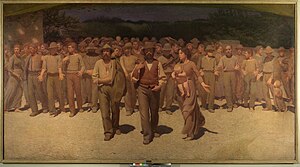
And now for something completely different. Actually, I'm not sure I have seen this painting, for I had to google its precise location and Wikipedia says that there is an earlier version which is in the Pinoteca di Brera in Milan. I'm almost certain that's what I've seen. This link has some comment on why the painting has such a deep symbolism but the main reason I love this is in its connection to Bertolucci's Film, Novecento, which is certainly my favourite Italian film and possibly my favourite film. The painting itself is best viewed while listening to Bella Ciao on the iPod.
6. The Legend of the True Cross (Piero della Francesca) Church of San Francesco, Arezzo
.
A bit of a cheat this, since its not really a painting but a fresco cycle, from which I've chosen but one detail. But it's in Arezzo, and next door to my absolute favourite restaurant in the whole of Italy, L'Antica Osteria L'Agania which means, in reality, my favourite restaurant in the whole world. I particularly recommend the ribollita, followed by the slow roasted stuffed rabbit in herbs. Definitely red wine and a wee pannacotta to finish. Oh, and fagiolini bianchi. Don't at any cost omit the fagiolini bianchi..
Anyway, about the frescoes. The story is a lot of nonsense but the execution flawless. For almost half my life they seemed to be under restoration to the extent that when the restoration was finally finished the whole town was hung with banners proclaiming "Bentornato Piero!" Never a truer word spoken. And a wee bonus for film buffs. When the Sikh Officer hoists Juliette Binoche up by torchlight inside a Church in The English Patient, it is these very frescoes that he hopes will cheer her up. Awww!
7. The Art of Painting (Vermeer) Kunsthistoriches Museum, Vienna

Vermeer, eh. Nowadays I suspect he might be subject to psychological "help" such is his attention to detail and quest for absolute perfection. But the work is.............perfect. Lots of choice here of course, few artists have so many "famous" paintings. I've gone for the Vienna one however, as there was an exhibition devoted to this painting alone when we were last there. Think of the effort alone just in getting the squared tiled floor in such perfect perspective; and the light shadow; and the drapery. I could bore you to death with the allegories apparently concealed within, if I could remember them from the exhibition. Instead I'll tell you that the Kunsthistoriches Museum Cafe has the best cakes ever encountered in an art gallery. Go there. See the paintings as well if you have the time.
8. Las Meninas (Velasquez) Prado, Madrid
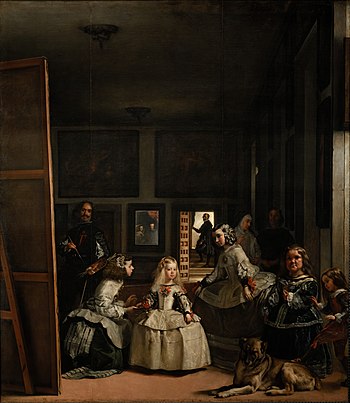
Everybody says Barcelona is superior to Madrid but I've never been to Barcelona. Madrid is a bit like the proverbial curates egg. In large parts its hung over with the ghost of Franco by way of Philip II and the Churches are, generally, undistinguished baroque. You kind of get the impression most of the free thinkers effed off to Austria and the low countries when Charles V announced he'd had enough and the place has never really recovered
But the galleries in Madrid, three of the greatest in the world, are worth a visit alone. And never were undistinguished Royal Family better served by an artist than the later Hapsburgs by Velasquez. This is his masterwork, at least according to the Spanish, who attribute it the greatest painting of all time. To the outside observer however it also speaks of the artificiality, indeed grotesqueness of the age. The little girls seem no more in a natural environment than the dwarves and indeed almost personally covered in a slight layer of dust.
Technically, of course, the painting is brilliant with the retreating figure framed in the light of the doorway and, above all, the reflection in the mirror, no doubt intended to show off that mastery.
But, above all, it seems a melancholy painting. All the odder then that Philip IV regarded it as his favourite. Maybe he saw what was coming.
9. Madonna and Child with Ss Nicholas of Bari, Peter, Mark and Benedict (Giovanni Bellini) The Frari, Venice

Nobody paints Madonnas like Bellini. Not Leonardo, not even Raphael. Again I could be spoiled for choice but actually its not difficult at all. This is easily my favourite. Actually, I'd quite happily ditch the supporting Saints but I don't want to second guess the artist.
Again, location is everything. This painting hangs in the Sacristy of the Frari. Above the main altar of the Church itself is a painting many Italians, at least at one time, claimed to be the greatest in the World, an Assumption by Titian. The latter painting is gigantic, apparently the largest altarpiece in Venice, and I really don't like it at all. It's trying too hard, I suppose. Religion as soap opera.
It's therefore a joy in itself to step out of its view and contemplate this Bellini. Simple, beautiful, quiet. And Our Lady wears blue. Always her best colour. That's all.
10. The Resurrection. (Piero della Francesca) Borgo San Sepolocro
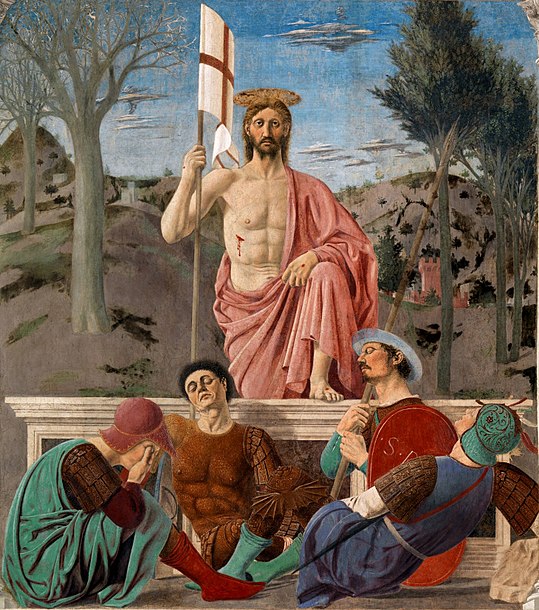
Now, its not just because I've disclosed this to be my favourite painting on a previous occasion that Piero gets two entries. The man's a genius. I wouldn't have swapped this one for anything but, above, instead of the Legend of the True Cross, I could just as easily have chosen the Flagellation or the Madonna del Parto or...........
Difficult to add to what I said about this when I wrote of it previously so, instead, I'll content myself with another lunch recommendation; don't eat in San Sepolocro, go to Umbertide. If your prepared to do that, I'll let you into a secret.
But that's enough art for now.
No comments:
Post a Comment